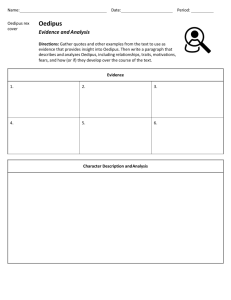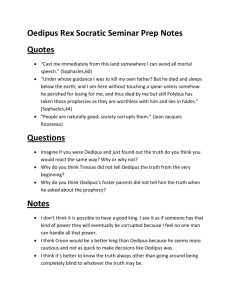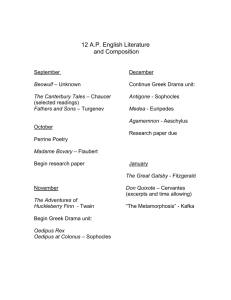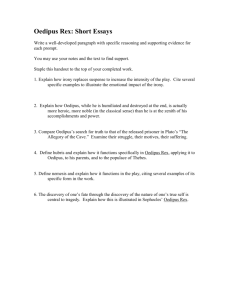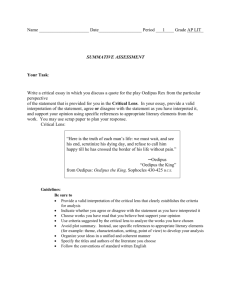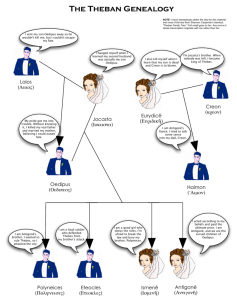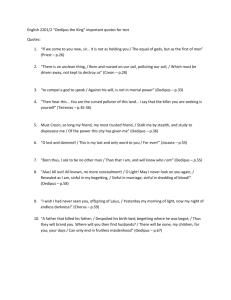Oedipus the King Unit Plan: 9th Grade Curriculum
advertisement
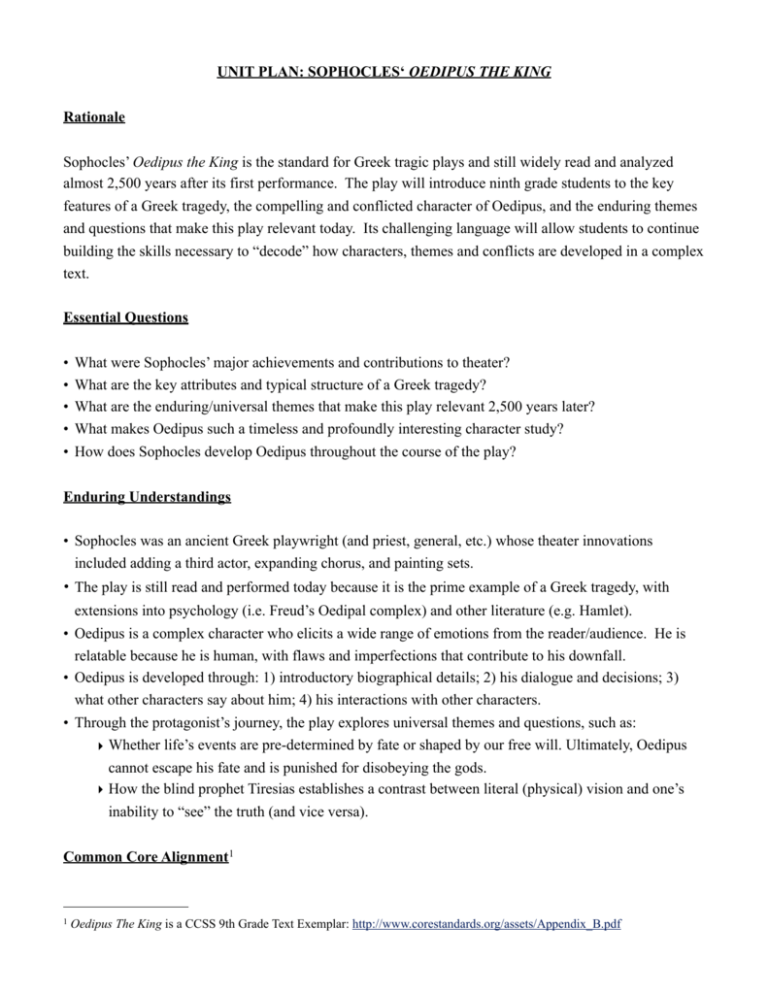
UNIT PLAN: SOPHOCLES‘ OEDIPUS THE KING Rationale Sophocles’ Oedipus the King is the standard for Greek tragic plays and still widely read and analyzed almost 2,500 years after its first performance. The play will introduce ninth grade students to the key features of a Greek tragedy, the compelling and conflicted character of Oedipus, and the enduring themes and questions that make this play relevant today. Its challenging language will allow students to continue building the skills necessary to “decode” how characters, themes and conflicts are developed in a complex text. Essential Questions • • • • • What were Sophocles’ major achievements and contributions to theater? What are the key attributes and typical structure of a Greek tragedy? What are the enduring/universal themes that make this play relevant 2,500 years later? What makes Oedipus such a timeless and profoundly interesting character study? How does Sophocles develop Oedipus throughout the course of the play? Enduring Understandings • Sophocles was an ancient Greek playwright (and priest, general, etc.) whose theater innovations included adding a third actor, expanding chorus, and painting sets. • The play is still read and performed today because it is the prime example of a Greek tragedy, with extensions into psychology (i.e. Freud’s Oedipal complex) and other literature (e.g. Hamlet). • Oedipus is a complex character who elicits a wide range of emotions from the reader/audience. He is relatable because he is human, with flaws and imperfections that contribute to his downfall. • Oedipus is developed through: 1) introductory biographical details; 2) his dialogue and decisions; 3) what other characters say about him; 4) his interactions with other characters. • Through the protagonist’s journey, the play explores universal themes and questions, such as: ‣ Whether life’s events are pre-determined by fate or shaped by our free will. Ultimately, Oedipus cannot escape his fate and is punished for disobeying the gods. ‣ How the blind prophet Tiresias establishes a contrast between literal (physical) vision and one’s inability to “see” the truth (and vice versa). Common Core Alignment1 1 Oedipus The King is a CCSS 9th Grade Text Exemplar: http://www.corestandards.org/assets/Appendix_B.pdf • RL.9-10.1 Cite strong and thorough textual evidence to support analysis of what the text says explicitly as well as inferences drawn from the text. • RL.9-10.2 Determine a theme or central idea of a text and analyze in detail its development over the course of the text, including how it emerges and is shaped and refined by specific details; provide an objective summary of the text • RL.9-10.3 Analyze how complex characters (e.g., those with multiple or conflicting motivations) develop over the course of a text, interact with other characters, and advance the plot or develop the theme. • RI.9-10.5 Analyze in detail how an author’s ideas or claims are developed and refined by particular sentences, paragraphs, or larger portions of a text. • W.9-10.2b Develop the topic with well-chosen, relevant, and sufficient facts, extended definitions, concrete details, quotations, or other information and examples appropriate to the audience’s knowledge of the topic. • W.9-10.2e Establish and maintain a formal style and objective tone while attending to the norms and conventions of the discipline in which they are writing. • W.9-10.2f Provide a concluding statement or section that follows from and supports the information or explanation presented (e.g., articulating implications or the significance of the topic). • W.9-10.3d Use precise words and phrases, telling details, and sensory language to convey a vivid picture of the experiences, events, setting, and/or characters. • SL.9-10.1 Initiate and participate effectively in a range of collaborative discussions (one-on-one, in groups, and teacher-led) with diverse partners on grades 9–10 topics, texts, and issues, building on others’ ideas and expressing their own clearly and persuasively. • SL.9-10.6 Adapt speech to a variety of contexts and tasks, demonstrating command of formal English when indicated or appropriate. • L.9-10.1 Demonstrate command of the conventions of standard English grammar and usage when writing or speaking. • L.9-10.2 Demonstrate command of the conventions of standard English capitalization, punctuation, and spelling when writing. Informational Texts The primary text will be supplemented by an informational text on the “life and times” of Sophocles (used to front load with information about the playwright, Greek civilization/beliefs, and characteristics of a Greek tragedy). Students also read a nonfiction article about the Oedipal Complex. UNIT PLAN: SOPHOCLES‘ OEDIPUS THE KING (Lesson Plan Samples) Lesson #5-6 (2-day lesson) Aim: How do dramatic irony and the new motif of blindness vs. sight further develop our characterization of Oedipus? Do Now: Copy the following: 22) degradation; 23) sanction; 24) perjuror; 25) culprit 26) brazen; 27) elicit; 28) scapegoat; 29) dismay; 30) affliction; 31) pestilence; 32) ominous Activity: Vocabulary; Go over HW #1; Read the Strophe & Antistrophe and begin Episode 1 Author’s Craft: Dramatic Irony As We Read: 1) What does Oedipus promise anyone with information about who the murderer is? 2) What are the penalties if he finds the murderer himself? 3) What will he do if the murderer is someone within his own circle? 4) What duty does Oedipus feel to the former king? 5) Who is Tiresias and how does he come into the story? 6) What tone does Oedipus take on with Tiresias initially? Is it common for a king to speak with a prophet in this way? What inferences can we make about the king and/or society? 7) How does his tone change throughout their conversation? 8) What does Oedipus believing is actually going on behind his back? 9) What does Tiresias reveal that readers/audiences already know? 10) What fate awaits Oedipus as an old man? ** Some of the post-reading questions, students will be asked to write a response to first, and then we will have a class share-out and take notes. Post-Reading Questions: 1) Make an inference about how Oedipus feels after Tiresias tells him his future. Use textual evidence and refer to his tone/attitude and his self-image. 2) How is Tiresias’ tone different from that of Oedipus throughout their conversation? To what do you attribute this difference? 3) Why do you believe Tiresias is not afraid of the king? Lesson 13 Aim: How can we expand our understanding of Sophocles’ play by working with our peers to analyze the plot structure, the characters, and the author’s intentions? Do Now: Make a list of the key characters and 2-3 of their main attributes. Activity: Students will work in groups. Group work is differentiated to allow students to contribute their thoughts as we review the plot structure, author’s craft, and author’s intentions. This two day activity (work and class share-out) allows students to prepare for their upcoming exam and build their ideas for the essay assignment. Additionally, students will be able to identify and review significant quotes throughout the story (something many of them struggled with on the last essay assignment) This assignment also allows for collaborative work and conversation among students. Groups are designed by the teacher for the purposes of differentiation. Directions for Group Work: 1) Sit in a circle and separate your group from other groups 2) Every group member must record the answers in your notebook – do not write on the paper Day 1 – group work and begin share-out Day 2 – complete share-out Sample Group Assignments: Group 1: Belief in the gods 1) Examine the people’s attitudes toward the gods as expressed in the Choral Odes. • Compare and contrast their views with those of the royal family (i.e. Oedipus and Jocasta). • What does Sophocles show about the citizens and how they evolve through the story? • Identify a quote from the story that best reflects the beliefs of the ancient Greeks when this play was first performed. Group 2: Then & Now – Why is this play popular? 1) Think about why Sophocles presented this story to the people of ancient Greece. What questions might it have raised with the ancient Greek audience? (consider their belief system, along with plot structure and lessons from the story of the protagonist.) 2) Why is this play still widely read by students across the country? What makes it relevant today? Group 3 – Author’s Craft 1) Find examples of the following elements of author’s craft, and explain how they contribute to a theme (identify which theme): Dialogue – advantage or disadvantage of telling this story as a play Dramatic Irony Motif Metaphor Conflicts (identify 3) Mood Lesson #14 (2-Day Lesson) Aim: How does viewing the film version of Oedipus compare with reading the play, and how does it build our understanding of the story? Do Now: Take out notebooks and review handout. Activity: The 1968 film version of Oedipus the King is one of few movie productions of a Greek tragic play, and was shot at a ruined theater in Greece. It stars Christopher Plummer as Oedipus, Orson Welles as Tiresias, and Donald Sutherland as the lead member of the Chorus. Students will watch these scenes: Oedipus meeting with Tiresias: 22:30-31:33 Oedipus talks privately with Jocasta: 45:00-51:00 The Messenger delivers an update: 1:00:00-1:07:00 Oedipus questions the Shepherd: 1:09:30-1:14:00 Blind Oedipus in final scene: 1:20:00 - 1:35:00 http://www.youtube.com/watch?v=mAgvdfyAiJw As students view the film, they will answer the following questions (double homework grade): Day 1: Describe the setting – time of day, location, scenery. How does the “authenticity” of shooting the film in Greece affect your viewing experience? Compare the physical appearances (looks, age, attire, etc) of the characters as depicted in the film vs. the conception you had developed in your mind as we read the story. How are they similar and/or different? How is Oedipus depicted different than the other characters? How do non-verbal cues like facial expressions, hand gestures, eye contact contribute to the emotions and impact of the different scenes? Cite specific examples. Day 2: This is a movie production (with actors, directors, etc.) - compare your viewing experience in this format to what it might have been like to see the play performed live in a huge coliseum. What are the advantages and disadvantages of the different formats? What, if anything, did watching the film version contribute to your understanding of the story? Did you enjoy watching the film version? Why or why not? Would you give it a fresh or rotten tomato? What was your favorite and/or most memorable scene, and why? Homework: Study for Wednesday test. Lesson 17 Aim: How can going over the unit test help us review key concepts in Sophocles’ play and what effective test taking strategies can we identify for future exams? Do Now: Write down the steps you took in studying for this exam. Activity: The purpose of this lesson is to make sure students understand why they answered incorrectly on specific questions on the unit exam and to help students acquire effective test taking strategies. We will stop to analyze the questions and answers and end the lesson with a list of test taking strategies: Read the directions, look at all the sections to see what you should spend more time on (know your strengths) read the sub-headings, read all the choices, use process of elimination, and use other questions to help with those you get stuck on. Go over your answers at the end. We will also discuss the importance of studying at home and come up with a plan for what students can do to prepare at home: Study each day that you have the study guide (20 min. per day, minimum), make flash cards, find a quiet place – room at home, public library, school library. Things to do in advance: bring supplies (coming in prepared makes you less nervous & wastes less time), make sure you have the study guide/materials (absent = copy someone’s notes!!), and come to tutoring (prioritize your success). You must take notes in class. If the teacher writes it on the board, it goes into your notebook – your English Class notebook. Lesson 21 Aim: How can examining samples of strong writing help us write our own introductions & conclusions? Do Now: Review: The last time we wrote our essays, what did we do to build up our introductions and our conclusions? Activity: Students will look at samples of their classmates work from the previous essay on perks to identify the strengths of the writer’s introduction & conclusion. The purpose of this exercise is to help students develop a list of tips for writing an introduction & a conclusion. Guided Questions: • What is the writer’s thesis? Where does he/she insert the thesis? • How does he/she expand on the thesis statement? (Examine the last two sentences of the introduction) • What does the writer not do in the introduction? • What purpose do you believe the 1st sentence of this paragraph serves? • How does the 1st sentence of this conclusion relate to the writer’s thesis statement? • How do the 2nd and 3rd sentence compare to the writer’s body paragraphs? • What does the writer connect the story to in his/her last sentence? HW #2-3: To be done on loose-leaf: Intro, 3 body paragraphs (strong topic sentences, 2 quotes, & one example of author’s craft), and a conclusion. Assessments 1. Uniform Multiple Choice Test English 2 Mr. Rio Name: __________________ Directions: Use the scantron to bubble in the best answer. Sophocles, Greek Theatre, and the Gods 1) When was Oedipus the King written? (a) 5th century A.D. (b) 5th century B.C. (c) 4th century A.D. (d) 4th century B.C. 2) How did Sophocles influence Greek Theatre? (a) He increased the size of cast (b) He introduced variations in music (c) He incorporated painted scenery (d) All of the above 3) Sophocles did more than just write plays and contribute to Greek Theatre. What did his experience(s) outside the arts expose him to? (a) Religion (c) Politics (b) War (d) All of the above 4) Why did the ancient Greeks go to the theatre? (a) For entertainment (c) To learn something (b) To honor Dionysus (d) All of the above 5) Which of the following Greek gods is known as the king of the gods? (a) Apollo (c) Zeus (b) Dionysus (d) Venus 6) Which of the following gods is responsible for knowledge and prophecy? (a) Zeus (c) Dionysus (b) Apollo (d) Venus The Royal Family For questions 7-13, bubble in A for True and B for False 7) Jocasta is Oedipus’ mother. 8) Oedipus is Jocasta’s husband. 9) The former king of Thebes is Oedipus’ father. 10) Creon is Oedipus’ uncle. 11) Antigone is Oedipus’ sister. 12) Oedipus is Antigone’s father. 13) Oedipus is the son of Zeus. Locations and Key Events 14) Oedipus was born in __________, raised in ___________, and traveled to ____________ to speak with the Oracle. (a) Colonus...Athens...Thebes (c) Corinth...Thebes...Delphi (b) Thebes...Cithaeron...Corinth (d) Thebes...Corinth...Delphi 15) The Oracle at Delphi proclaimed that Oedipus’ fate was to: (a) Kill his father and marry his mother (c) Leave Corinth to save the city of Thebes (b) Kill the King of Thebes by accident (d) Have four children with his mother 16) What happened at Phocis (where the three roads meet)? (a) Oedipus killed the King of Thebes (c) Oedipus fulfilled the first part of his fate (b) Oedipus killed his biological father (d) All of the above 17) Where was Oedipus taken to meet his death as a baby? (a) Corinth (c) Cithaeron (b) Delphi (d) Thebes 18) What two people saved baby Oedipus’ life? (a) Two shepherds (b) Two officials from the royal court (c) His biological mother & father (d) Two prophets 19) Why is the city of Thebes faced with a plague when the story begins? (a) The gods are angry at the people for not investigating Laius’ murder. (b) The gods are unhappy about the corruption that takes place in the city. (c) Both A and B (d) None of the above, the city faces a plague at the end of the story 20) During the rising action, ________ tries to make Oedipus see the truth while _______ tries to shield Oedipus from the truth. (a) Tiresias; Creon (c) Jocasta; Tiresias (b) Creon; Tiresias (d) Tiresias; Jocasta 21) What is the turning point (climax) of the story? (a) When Jocasta hangs herself (c) When the messenger & shepherd confirm the truth (b) When Oedipus argues with Creon (d) When Oedipus asks Creon to watch out for his daughters Analyzing the Characters 22) When Oedipus interacts with Tiresias and with the Shepherd from Thebes, what side of the protagonist do readers notice? (a) His temper (b) His ability to abuse his power (c) Both A and B (d) None of the above – he behaves differently with each of them. 23) What do Creon, Tieresias, and the two shepherds have in common? (a) They are all afraid of Oedipus (c) They are all natives of Thebes (b) They highlight Oedipus’ flaws (d) They are all less powerful than Oedipus. 24) Which of Oedipus’ characteristics is most consistent throughout the play? (a) His relentless pursuit of information (c) His modest way of living (b) His selfless concern for others (d) His clear-headed leadership 25) Which of the following is the best way to characterize Jocasta’s feelings towards the gods & prophecy? (a) Like the citizens of Thebes, she fears and respects the gods (b) She is uncertain and confused about her beliefs all throughout the story. (c) She refuses to accept the prophecy of the gods, even as she is dying. (d) She disrespects the gods throughout most of the story and sees them as a last resort for help. 26) Tiresias claims he is protected by Apollo. What does this give him throughout his conversation with Oedipus? (a) Confidence (c) Fearlessness (b) Certainty (d) All of the above 27) What do the following characteristics have in common: rage, stubbornness, and excessive pride? (a) These are all examples of human flaws. (b) These characteristics contribute to the protagonist’s downfall. (c) These qualities are what make Oedipus a timeless and relevant character. (d) All of the above. 28) What do Laius and Oedipus have in common? (a)Their stubbornness contributed to their destruction/death. (b) They both suffered from excessive pride. (c) They were both raised in Thebes. (d) Both A and B. Author’s Craft & Plot Structure 29) When this play is performed, the purpose of the Chorus is to: (a) Reflect the mood of the people in Thebes (b) Make a connection between the audience and the actors (c) Both A and B (d) None of the above 30) Sophocles describes Oedipus’ bleeding as “a spurt of black ensanguined rain.” This description contains which of the following literary devices? (a) Simile (c) Allusion (b) Metaphor (d) Irony 31) Oedipus blinds himself and blood pours from his eyes. This act symbolizes a cleansing or purging of sins. In Greek tragedy this is known as: (a) Hamartia (c) Mimesis (b) Epilogue (d) Catharsis 32) Throughout the story the audience and readers know that Oedipus is married to his mother and has killed his biological father, but Oedipus does not know this. What literary device is the writer using? (a) Conflict (c) Dramatic Irony (b) Motif (d) Comic Relief 33) Blindness vs. Sight is an example of: (a) Theme (c) Motif (b) Conflict (d) Dramatic Irony 34) The moment when Jocasta runs into the palace and hangs herself is a part of the story’s: (a) Exposition (c) Rising action (b) Climax (d) Falling action 35) We find out that Thebes is suffering from a plague and that Oedipus has a horrible destiny ______ (a) During the climax (c) During the resolution (b) During the exposition (d) During the rising action 36) Which of the following is an example of a conflict that Oedipus has with himself? (a) His feelings towards Creon (c) His refusal to look within himself (b) His fear of the Sphinx (d) His fear of the gods at the end of the story 37) What makes this play a tragedy? (a) The downfall of the main character (b) The downfall of someone once proud & powerful (c) The sins committed by the protagonist (d) This is not a tragedy; it is a comedy Author’s Intentions 38) What did Sophocles want readers/audiences to question/consider? (a) The power of the gods over one’s destiny. (b) The role of an individual’s free will. (c) The role & power of one’s fate. (d) All of the above 39) Why did Sophocles choose to structure his story around someone as powerful as a king rather than a common man? (a) To show that kings are often not as they appear. (b) To show how sinful and deceiving royalty may be. (c) To show that anyone, regardless of the power they hold, may crumble. (d) To show his disgust with people in power. 40) What makes this work of literature still relevant so many centuries later? (a) The personality of the protagonist makes him a relevant character, even in modern times. (b) The play explores what it means to be a good leader. (c) Many people today still debate over the power of fate & free will. (d) All of the above. For #41-50, read the passage below and answer the questions. There is an ancient proverb that says, "Temper gets you into trouble, pride keeps you there." While this is certainly true for all of us, it is especially important for those that strive to become great leaders. In my over thirty years of training and developing leaders, I have become convinced that someone who has difficulty controlling his temper can never effectively lead. In addition, an individual who permits his personal pride (a.k.a. ego) to get in the way of effective leadership is ill-suited to be a leader. Every individual who has ever led any organization invariably, at one time or another, upsets someone, either by something he did, did not do, said, or did not say. Sometimes, someone feels that a leader did not thank him sufficiently, and becomes offended. The greatest leaders emphasize their communication and people skills, and reach out to these individuals to discover the issue, and to discuss it one to one, without any pre-bias or prejudice. One of the essentials of great leadership is the ability to sublimate one's ego for the good of the organization. Unfortunately, far too many individuals that lead organizations instead simply get angry and "develop an attitude" towards the already offended party. A great leader realizes that there is often a miscommunication or misinterpretation that causes the riff, while the weaker leader gets mad, and often tries to get even. This anger is often the potential downfall of the leader, who then often loses his temper, and even worse, demonstrates this temper in public. Others observe this fete of anger, and develop a lower opinion of the leader, creating a further obstacle to effective leadership. Even worse is when the individual in the leadership position becomes offended that someone had the audacity to criticize him, and did not "appreciate" all his hard work and efforts. Many of these poorly fitted leaders then develop a "Can't please them anyway so why try" attitude, which then causes a dearth of leadership. These people's pride and ego often causes reactive instead of proactive behavior, which then further offends others. In addition, and with generally more dire ramifications to the organization, the leader's ego "turns off" members, and creates and casts a negative image both on the organization and the leader himself. Overly prideful leaders often find it very difficult "to let go" and continue to harbor a grudge. They often become petty and spiteful, and place their pride ahead of any of the organization's or its members needs. Every organization should carefully and fully develop and explore these issues of temper and pride as part of their professionally designed and implemented leadership training program. 41) What is the main idea of the 1st paragraph? (a) Temper & pride are most destructive in people who are leaders. (b) If you lose your temper and have too much pride you will not be a successful leader. (c) People with big egos make bad leaders. (d) People who lack self-control cannot lead others. 42) According to the 2nd paragraph, what quality should a good leader possess? (a) The ability to befriend anyone. (b) The ability to communicate with everyone. (c) The ability to identify how many people are not happy. (d) The ability to never feel offended. 43) According to the 2nd paragraph, one might infer that good leaders: (a) Are comfortable being scared. (b) Appreciate everyone in their organization. (c) Sacrifice their needs for the feelings of others. (d) Confront problems without being emotional. 44) According to the 2nd paragraph, what should a leader never do when everyone is watching? (a) Show fear. (a) Panic. (b) Lose control over his/her emotions. (d) Take things personally. 45) What does the word dearth in the 3rd paragraph most likely mean? (a) Increase (c) Change (b) Decrease (d) Problem 46) According to the 3rd paragraph, what is the difference between a reactive and proactive leader? (a) The reactive leader plans in advance, while the proactive leader is spontaneous. (b) The reactive leader is offended by others, while the proactive leader suffers from excessive pride. (c) The reactive leader seeks a solution, while the proactive leader seeks revenge. (d) The reactive leader seeks revenge, while the proactive seeks a solution. 47) According to this writer, what can organizations do to prepare their leaders for success? (a) The organizations should do background checks on new employees. (b) The organizations should require on the job training on an annual basis. (c) The organizations should have a well designed training program. (d) There is nothing organizations can do because people don’t always show their true colors right away. 48) Author’s Purpose: What would be the most appropriate title for this article? (a) Angry people don’t make good leaders. (b) Too much pride = Too many problems. (c) Proactive communication and being a good leader. (d) Keys to effective leadership: The do’s and don’ts of leadership. 49) Text-Text: What could a modern day Oedipus learn from this article? (a) The destructive power of excessive pride. (b) How unprofessional it is to lose one’s temper, especially in public. (c) The power of communication, especially when addressing conflicts. (d) All of the above 50) Which of the following quotes from Oedipus best fits with the main idea of this article? (a) Swift thinking never made just thought. (b) A stubborn mind is nothing to be proud of. (c) Such men justly bear the tempers they created. (d) Both B and C. 2. Vocabulary Test English 2 Mr. Rio Name: __________________ Directions: DO NOT WRITE ON THIS TEST. Bubble in your answers on the scantron. For #1-10, bubble in A for True and B for False. 1) To revere means to disrespect. 2) Lamentation means cries of joy. 3) Someone who is brazen is very bold. 4) To abhor someone means to love them dearly. 5) If your hope dwindles it means it is beginning to disappear. 6) If Ms. Reznik wants to know when she will win the lottery, she might consult an oracle. 7) A sinking boat has good buoyancy. 8) Liz’s boyfriend proposed when there was an ominous song playing in the background. This is a sign for a long, happy marriage. 9) If Mr. Rio is adamant about homework, it means he is very strict about it and expects it to be done. 10) Someone who is a wretch makes a great roommate and a great party companion. For # 11-14, match the word with the correct definition. 11) Someone caught lying under oath. (a) Havoc 12) Being firm in one’s beliefs. (b) Fathom 13) Complete & total destruction. (c) Perjuror 14) Think about & understand. (d) Resolute (e) Abide For # 15-18, select the vocabulary word from the box that best fits the sentence. (a) Treachery (b) Elicit (c) Culprit (d) Brawl (e) Sham 15) When the two students got into a fight in the cafeteria, they were suspended for five days. 16) On Law & Order, the investigators must find the guilty individual/party by the end of the show. 17) The king had the court official executed for betrayal. 18) The dean questioned the witnesses so that she could draw out information about the fight. For #19-24, identify the synonym of the vocabulary word. A synonym is a word that is similar in meaning. 19) Beseech: (a) Pray 20) Malevolence: (a) Kindness (b) Beg (c) Fight (d) Conquer (b) Fearlessness (c) Evilness (d) Hopelessness 21) Prowess: (a) Expertise (b) Lack of skill (c) Love of (d) Dislike of 22) Treason: (a) Tenacity (c)Triumph (d) Treachery 23) Scruple: (a) Certainty 24) Degradation: (a) Dismay (b) Terrible (b) Doubt (c) Confidence (d) Decision (b) Determination (c) Downgrade (d) Defensiveness For # 25-30, identify the antonym of the vocabulary word. An antonym is a word that is opposite in meaning. 25) Excessive: (a) Too much (b) Just enough (c) Too little 26) Rebuke: (a) Reward (b) Scold (c) Remember (d) Sacrifice 27) Sullenly: (a) Happily (b) Nervously (c) Gloomily (d) Awkwardly 28) Infamy: (a) Having a bad reputation (c) Having no reputation (b) Happy a good reputation (d) Having an uncertain reputation 29) Unscathed: (a) Unharmed 30) Dormant: (a) Deluded (b) Unnoticed (c) Harmed (b) Downgraded (c) Dwindled (d) Plenty (d) Heard (d) Discovered For #31-35, identify the vocabulary words that best fit the sentence. 31) The leader punished the traitor by making him an outcast. (a) Sovereign; Pestilence (b) Reign; Pariah (c) Sovereign; Pariah (d) Reign; Perjuror 32) “Your punishment shall be death”, shouted the king, leaving the soon-to-be widow in utter sadness. (a) Affliction; Dismay (b) Sanction; Dismay (c) Malevolence; Affliction (d) Scruple; Infamy 33) The townspeople described the man’s actions as an causing much hatred and disgust and they said his dishonesty about the whole situation was disgusting. (a) Affliction; Abomination (c) Abomination; Appalling (b) Addiction; Ridiculous (d) Amusement; Undermining. 34) I remember seeing the princess run around in a playful manner for the last time until she came to the castle and found that it had been destroyed. (a) Fathom; Dismayed (b) Abide; Revered (c) Frolic; Decimated (d) Fathom; Dwindled 35) The plague was responsible for much pain and suffering that could be seen in the city. (a) Punishment; Affliction (b) Pestilence; Affliction (c) Affliction; Pestilence (d)Disease; Pestilence For #36-40, identify the part of speech – noun, verb, or adjective, based on how the word is used in the sentence. For Noun, choose A. For Verb, choose B. For Adjective, choose C. 36) The king’s reign became known for the death and suffering that occurred under his rule. 37) The woman could be heard lamenting over the coffin of her deceased son. 38) His teacher called his parents to complain about the excessive talking that was disrupting algebra class. 39) The coach warned his players not to brawl with the opposing team. 40) The elderly woman was angered by the advertisement that she felt was a sham targeting widowed women. 3. Essay Assignment English 2 Mr. Rio Name: ______________________ ESSAY ASSIGNMENT Due Date: Monday, March 18, 2013. For every school day that your essay is late, it will lose 3 points. The Task: Write an essay in which you prove your thoughts on the statement below and use the protagonist from Sophocles’ Oedipus the King to build your argument. “Circumstances are beyond the control of man; but his conduct is in his own power.” — Benjamin Disraeli Guidelines: · Begin with an introduction that includes a strong thesis. Include the title & author of the text you will refer to in your essay. · Prove your thesis by developing three body paragraphs with relevant and specific details. · · · Include two quotes from the story and cite them properly. Include and explain one example of author’s craft. It should build on your ideas within that particular paragraph. End with a conclusion that re-states your thesis and summarizes your key points. Format: ! Your essay must be typed – Size 12, Times New Roman Font. ! Double-space your essay. ! 1” Margins all around. ! No Title Page – just your name & class period in the corner. Alignment to CCSS: W.9-10.2b: Develop the topic with well-chosen, relevant, and sufficient facts, extended definitions, concrete details, quotations, or other information and examples appropriate to the audience’s knowledge of the topic. W.9-10.2e: Establish and maintain a formal style and objective tone while attending to the norms and conventions of the discipline in which they are writing. English 2 Name: ____________________ Rubric for Essay 4 INTRODUCTION The introduction is at least 4 sentences and is engaging. The thesis is clear. Writer includes title and author. DEVELOPMENT Each body THROUGH paragraph begins EVIDENCE with a topic sentence that ESSAY MUST supports the thesis. HAVE 3 BODY All the details are PARAGRAPHS specific and relevant. This includes author’s craft and quotes. 3 The introduction is at least 4 sentences. The thesis is clear. Writer includes title and author. 2 1 The introduction is too There is no short or the thesis is introduction. not clear. The title and author may be missing. Each body paragraph The topic sentences are There are not begins with a topic not clear. Only some of enough body sentence that the details are specific paragraphs supports the thesis. and relevant. This OR topic The majority of includes author’s craft sentences do details are specific and quotes. not support and relevant. This the thesis and includes the author’s not enough craft and quotes. relevant details, including (author’s craft and/or quotes.) The body The body The body paragraphs The body ORGANIZATION paragraphs are in paragraphs are in are not in logical or paragraphs logical/ logical/chronological chronological order. and the chronological order order AND the Many of the details in details in AND the details in majority of details in the paragraphs are not them are not each paragraph are each paragraph are in order and the writer in any order. in order. Writer in order. Writer repeats him/herself does not repeat does not repeat frequently. him/her self. him/herself. CONCLUSION Conclusion restates Conclusion restates Conclusion does not There is no key points and ends key points. restate key points. conclusion. with thought provoking statement. GRAMMAR Essay has no Essay has very few Essay has a significant Essay is full fragments, no run- fragments/run-on amount of fragments/ of fragments, on sentences, no sentences, run-on sentences, run-on contractions, and contractions, and contractions, and much sentences, does not use very little colloquial colloquial language. contractions, colloquial language. language. Writer Writer demonstrates and colloquial Writer demonstrates demonstrates confused understanding language. strong understanding of of how/when to use a Writer understanding of how/when to use a comma. demonstrates how/when to use a comma. that he/she comma. does not know how/ when to use a comma. _____ = _______ ->>> YOUR GRADE 20 100
